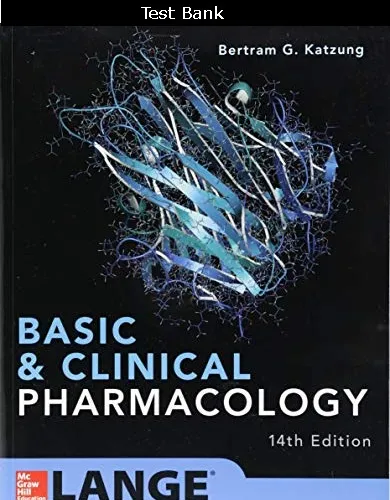Basic and Clinical Pharmacology 14th Edition Katzung Trevor Test Bank
$55.00 Original price was: $55.00.$23.00Current price is: $23.00.
Digital item No Waiting Time Instant Download
Chapters: 66
Chapters: PDF
ISBN-13: 978-1259641152
ISBN-10: 1259641155
Publisher: MG. Hill
Authors: Bertram Katzung
Description
Basic and Clinical Pharmacology 14th Edition Katzung Trevor Test Bank
Table of Contents
Authors
Section I Basic Principles
1. Introduction: The Nature of Drugs & Drug Development & Regulation
2. Drug Receptors & Pharmacodynamics
3. Pharmacokinetics & Pharmacodynamics: Rational Dosing & the Time Course of Drug Action
4. Drug Biotransformation
5. Pharmacogenomics
Section II Autonomic Drugs
6. Introduction to Autonomic Pharmacology
7. Cholinoceptor-Activating & Cholinesterase-Inhibiting Drugs
8. Cholinoceptor-Blocking Drugs
9. Adrenoceptor Agonists & Sympathomimetic Drugs
10. Adrenoceptor Antagonist Drugs
Section III Cardiovascular-Renal Drugs
11. Antihypertensive Agents
12. Vasodilators & the Treatment of Angina Pectoris
13. Drugs Used in Heart Failure
14. Agents Used in Cardiac Arrhythmias
15. Diuretic Agents
Section IV Drugs with Important Actions on Smooth Muscle
16. Histamine, Serotonin, & the Ergot Alkaloids
17. Vasoactive Peptides
18. The Eicosanoids: Prostaglandins, Thromboxanes, Leukotrienes, & Related Compounds
19. Nitric Oxide
20. Drugs Used in Asthma
Section V Drugs That Act in The Central Nervous System
21. Introduction to the Pharmacology of CNS Drugs
22. Sedative-Hypnotic Drugs
23. The Alcohols
24. Antiseizure Drugs
25. General Anesthetics
26. Local Anesthetics
27. Skeletal Muscle Relaxants
28. Pharmacologic Management of Parkinsonism & Other Movement Disorders
29. Antipsychotic Agents & Lithium
30. Antidepressant Agents
31. Opioid Agonists & Antagonists
32. Drugs of Abuse
Section VI Drugs Used to Treat Diseases of The Blood, Inflammation, & Gout
33. Agents Used in Cytopenias; Hematopoietic Growth Factors
34. Drugs Used in Disorders of Coagulation
35. Agents Used in Dyslipidemia
36. Nonsteroidal Anti-Inflammatory Drugs, Disease-Modifying Antirheumatic Drugs, Nonopioid Analgesics, & Drugs Used in Gout
Section VII Endocrine Drugs
37. Hypothalamic & Pituitary Hormones
38. Thyroid & Antithyroid Drugs
39. Adrenocorticosteroids & Adrenocortical Antagonists
40. The Gonadal Hormones & Inhibitors
41. Pancreatic Hormones & Antidiabetic Drugs
42. Agents That Affect Bone Mineral Homeostasis
Section VIII Chemotherapeutic Drugs
43. Beta-Lactam & Other Cell Wall- & Membrane-Active Antibiotics
44. Tetracyclines, Macrolides, Clindamycin, Chloramphenicol, Streptogramins, & Oxazolidinones
45. Aminoglycosides & Spectinomycin
46. Sulfonamides, Trimethoprim, & Quinolones
47. Antimycobacterial Drugs
48. Antifungal Agents
49. Antiviral Agents
50. Miscellaneous Antimicrobial Agents; Disinfectants, Antiseptics, & Sterilants
51. Clinical Use of Antimicrobial Agents
52. Antiprotozoal Drugs
53. Clinical Pharmacology of the Antihelminthic Drugs
54. Cancer Chemotherapy
55. Immunopharmacology
Section IX Toxicology
56. Introduction to Toxicology: Occupational & Environmental
57. Heavy Metal Intoxication & Chelators
58. Management of the Poisoned Patient
Section X Special Topics
59. Special Aspects of Perinatal & Pediatric Pharmacology
60. Special Aspects of Geriatric Pharmacology
61. Dermatologic Pharmacology
62. Drugs Used in the Treatment of Gastrointestinal Diseases
63. Therapeutic & Toxic Potential of Over-the-Counter Agents
64. Dietary Supplements & Herbal Medications
65. Rational Prescribing & Prescription Writing
66. Important Drug Interactions & Their Mechanisms
Appendix: Vaccines, Immune Globulins, & Other Complex Biologic Products
Index
Basic and Clinical Pharmacology 14th Edition Katzung Trevor Test Bank
Chapter 1. Introduction: The Nature of Drugs & Drug Development & Regulation
1. A nurse working in radiology administers iodine to a patient who is having a
computed tomography (CT) scan. The nurse working on the oncology unit
administers chemotherapy to patients who have cancer. At the Public Health
Department, a nurse administers a measles-mumps-rubella (MMR) vaccine to
a 14-month-old child as a routine immunization. Which branch of
pharmacology best describes the actions of all three nurses?
A) Pharmacoeconomics
B) Pharmacotherapeutics
C) Pharmacodynamics
D) Pharmacokinetics
Ans: B
Feedback:
Pharmacology is the study of the biologic effects of chemicals. Nurses are
involved with clinical pharmacology or pharmacotherapeutics, which is a
branch of pharmacology that deals with the uses of drugs to treat, prevent,
and diagnose disease. The radiology nurse is administering a drug to help
diagnose a disease. The oncology nurse is administering a drug to help treat a
disease. Pharmacoeconomics includes any costs involved in drug therapy.
Pharmacodynamics involves how a drug affects the body and
pharmacokinetics is how the body acts on the body.
2. A physician has ordered intramuscular (IM) injections of morphine, a
narcotic, every 4 hours as needed for pain in a motor vehicle accident victim.
The nurse is aware this drug has a high abuse potential. Under what category
would morphine be classified?
A) Schedule I
B) Schedule II





Be the first to review “Basic and Clinical Pharmacology 14th Edition Katzung Trevor Test Bank”